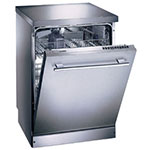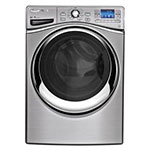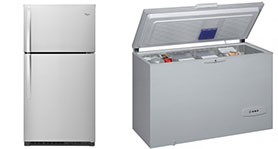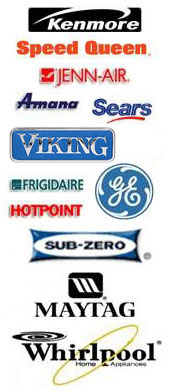
Dishwasher Care Tips
Wait until you have a full load before running the dishwasher. When loading the dishwasher, make sure no dishes obstruct the rotating spray arms. There's an arm that spins under the bottom rack, another above the top rack. Load more fragile items in the top rack. The highest-pressure jets are directed at the lower rack to help clean pots and utensils.
Scrape off as much surface food as possible and place larger and dirtier items on the bottom rack with cups, glasses and less soiled items on the top rack. Load plates and glasses so they aren't touching and put cutlery in the special basket, handles facing downwards.
These items can be washed in a dishwasher, with the following guidelines:
- Glassware - Any ordinary glassware and ovenware. Do not wash lead crystal glasses unless they carry a "dishwasher safe" label.
- Tableware - Most everyday crockery is safe. Bone china usually has under-glaze decoration and should be safe. Avoid antique or hand-painted and over-glaze decorated items. If in doubt, check with the manufacturer.
- Cutlery - Stainless steel and silver cutlery are normally suitable for machine washing, but it pays to rinse off any acidic food before loading to prevent any corrosion and, if possible remove the cutlery immediately after the cycle, to avoid prolonged exposure in a humid atmosphere. Do not mix steel and silver cutlery in the same basket and wash bone or wooden-handled items by hand.
- Plastics - Check whether they are dishwasher safe and do not place in the lower rack, where the heating element may affect the plastic during drying.
- Pans - Stainless steel is ideal for dishwashers. Aluminium can be washed in the machine, but may discolour during the rinsing. If in doubt, remove aluminium pans before the rinse cycle.
Always wash cast iron and wooden handled items by hand.
If your dishwasher has a water heating option, use it.
The dry cycle uses a lot of energy. During the winter months, when the air in the house is generally dry, you don't need to use this option. Instead, when the dishwasher stops, open it and pull out both racks. Everything will be dry in about an hour.
If the small holes in the spray arms become clogged with mineral deposits, you can reopen them using hot vinegar and a safety pin.
Top of Page

Washing Machine Care Tips
Most washer hoses are made of reinforced rubber. As they get older, they lose some of their resiliency and may be subject to bursting. A burst hose can spray hundreds of liters of water per hour across your floor or laundry room causing enormous damage As an added precaution, consider turning off the water supply to the washer whenever you'll be away for extended periods of time.
For best results, put detergent in before you load the washer. For most items, lowering the water temperature to warm wash and cold rinse will get your clothes clean and reduce your energy bills.
Small loads use almost as much energy as large loads. When possible, wait until you have a full load before running the washing machine. Most washer drain hoses hook over the side of a sink or into a pipe especially for that purpose. To prevent floods, make sure the hose is secure and can't rattle lose or shift out of position.
Never put rags, socks or similar items on shelves over the laundry sink. If one falls into the sink, it can clog the drain and cause a flood. To minimize the damage from a washer mishap, make sure there is a clear path from the washer to the floor drain.
Top of Page

Clothes Dryer Care Tips
- Clean the lint filter before or after each load. Don't forget to clean the back of the dryer where lint can be trapped.
- Do not dry clothing/fabric on which there is anything flammable (alcohol, cooking oils, gasoline, spot removers, dry-cleaning solvents, etc.). Flammable substances give off vapors that could ignite or explode.
- Don't forget to read manufacturers' warnings in use and care manuals that accompany new dryers. Also, warning markings can usually be found on the inside of the dryer's lid and take only minutes to read.
Top of Page

Refrigerators and Freezer Care Tips
Run and maintain your refrigerator and freezer at maximum efficiency:
- For food safety maintain your refrigerator temperature between 2-6°C and your freezer between -18 and -15°C; colder settings than this can waste up to 25 percent more energy.
- When defrosting food, plan ahead and put the frozen food in the refrigerator compartment where it will help keep the fridge cold while it thaws and thus save on electricity.
- Gently brush or vacuum the dust that can accumulate on the condenser coils located on the back of the refrigerator or freezer; this can sometimes save as much as 30 percent in electric consumption. Clean the outer and inner walls regularly with mild cleaning liquid.
- Leave enough space between your refrigerator and the walls or cabinets so air can circulate around the condenser coils at the back. Trapped heat from the coils and motor will needlessly increase your electric consumption.
- Keep the refrigerator full (but not packed, which prevents air from circulating). This allows the temperature to recover quickly after the door is opened and closed.
Top of Page

Stoves and Ranges
Proper maintenance and care is essential in keeping your Oven, Stove or Range running efficiently. Improper care will cause your unit to overwork by using more electricity to keep you clothes clean than if properly maintained. By following these tips, you can prolong the life of your Oven, Stove or Range and avoid many costly repairs.
Clean Ovens, Stoves and Ranges control panel regularly with a mild dish detergent. Clean the surface of the control panel with a nonabrasive mild cleaner. Do not spray or expose the control panel directly to liquids. Spray directly into the cloth, wipe clean and wipe dry. Abrasives may cause scratches and corrosion on glass control panels.
Clean burner drip pans thoroughly to bring out the shine needed to properly radiate heat back. To keep them functional, clean regularly. Never cover with aluminum foil because the foil may cause an electrical short.
Carefully clean around gasket seals. Use a mild, nonabrasive cleaner to clean in order to maintain proper temperature control and system efficiency. Replace corroded or brittle seals.
Remove glass coverings to replace light bulbs. Replace with 40 watt bulb usually located behind a small glass dome near the upper left or right side of the inside of the oven. Check owner’s manual for exact specs.
Self cleaning ovens are generally cleaned by heating the oven to high enough temperature to incinerate debris. However, this heat generated often causes more service calls to repair problems caused by the excessive heat. Do not use oven cleaners in self cleaning ovens.
Top of Page







